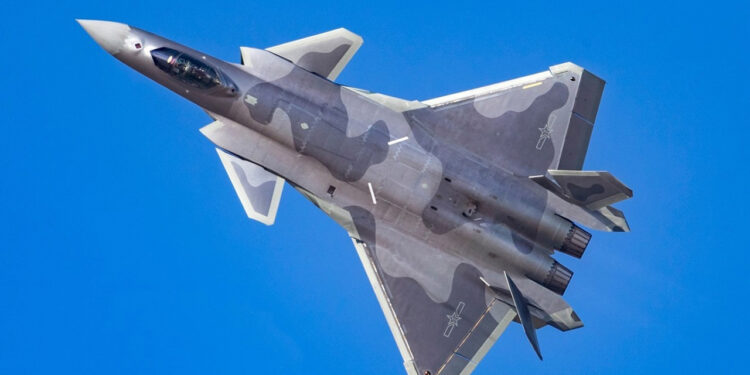By Tufail Bakshi
While India awaits the supply of fighter jet engines from the US, China has achieved significant advancements in its aviation capabilities. The country’s advanced J-20 stealth fighter has recently demonstrated its prowess, being equipped with the indigenously developed WS-15 turbofan engines.
Social media has been abuzz with photos and videos showcasing China’s J-20 stealth fighter successfully completing its maiden flight, powered by the WS-15 engines. The historic flight took place on June 28, originating from Chengdu Group’s primary test airport, situated adjacent to its production facility in the city of Chengdu.
The image of the J-20 aircraft adorned with the WS-15 engine has captured the attention of the media, with one photo revealing a conspicuous banner displaying the number 15, symbolizing the presence of WS-15 engines on board. This achievement marks a significant milestone in China’s journey towards achieving self-reliance in advanced aviation technology.
— PAF Falcons (@PAFFalconsPK) June 23, 2023
The WS-15 engine has undergone meticulous adaptation to fulfill the specific demands of the J-20 and is poised to replace the current WS-10 engine in use. As the mainstay aircraft of the People’s Liberation Army Air Force (PLA) in the coming years, the J-20’s capabilities are set to be enhanced significantly.
Initially, the early J-20 prototypes relied on AL-31 turbofan engines imported from Russia. However, to reduce its reliance on foreign suppliers, particularly Moscow, Beijing has been proactively engaged in research and development to achieve self-sufficiency in producing its own advanced engines. This move underscores China’s commitment to bolstering its domestic technological capabilities and achieving greater independence in its aviation industry.
The formidable WS-15 engine boasts an impressive thrust of up to 181 kilonewtons, promising a substantial boost in performance for the J-20 fighter. Among its key advantages is the remarkable supercruise capability, enabling the aircraft to attain supersonic cruise speeds without relying on an afterburner.
This cutting-edge feature not only elevates the J-20’s speed and agility but also contributes to reduced fuel consumption, facilitating extended mission durations with enhanced efficiency. The WS-15 engine empowers the J-20 with a distinct edge, making it a formidable asset in modern aerial warfare.
The development and construction of the highly classified WS-15 engine have been shrouded in secrecy, resulting in limited public information about its capabilities. As of the present, no images of the prototype or full-scale simulation of the WS-15 engine have been made public.
Dr. Malcolm Davis, a senior analyst at the Australian Strategic Policy Institute, emphasizes the strategic significance of the WS-15 engine’s development for China. This advancement serves as a crucial foundation for future aviation projects, especially for the development of sixth-generation air combat platforms and the enhancement of China’s Air Force capabilities.
In light of these advancements, Dr. Davis urges China to look beyond the reliance on F-35s until the 2040s and proactively pursue the development of advanced air combat capabilities. This proactive approach is essential to meet the challenges and demands of future warfare scenarios. China’s Air Force must continually strive to bolster its force’s quality and readiness, making the WS-15 engine a vital component of its future aviation endeavors.
The recent testing of the J-20 with the WS-15 engine marks a remarkable achievement for the Chinese aerospace industry. The development of this engine involved intricate complexities, demanding advanced technical expertise, and substantial investments.
This milestone becomes even more notable when compared to other countries like India and South Korea, which continue to grapple with challenges in developing their own engines and are still dependent on foreign engines for domestically produced fighter jets.
In a recent move, New Delhi has signed a Memorandum of Understanding (MoU) with General Electric (GE) to facilitate the production of the GE F414 jet engine in India, intended for the Mk2 Light Combat Aircraft (LCA) engine. The deal is progressing towards finalization, with only a few commercial terms awaiting approval from the US Congress. This step reflects India’s efforts to bolster its domestic aviation capabilities and reduce reliance on foreign engine supplies.
The agreement between India and General Electric (GE) includes the transfer of approximately 80% of manufacturing technology, a move that will significantly bolster India’s capabilities by acquiring crucial technologies. The contract signing is anticipated to pave the way for the production of the first engine within three years.
Experts, as quoted in a recent article by EurAsian Times, shared their perspectives on the deal. While acknowledging that it will help bridge the gap in aircraft production with China and enhance India’s defensive capabilities, they also highlighted potential limitations in future aircraft designs and the necessity for adaptations to these imported engines. Such constraints could hinder India’s domestic engine development program and affect its aspiration for self-reliance in this vital sector.
This contrast between the two Asian powers is stark – China has made notable strides in developing domestic engines, while India continues to grapple with challenges and remains dependent on imported engines.






